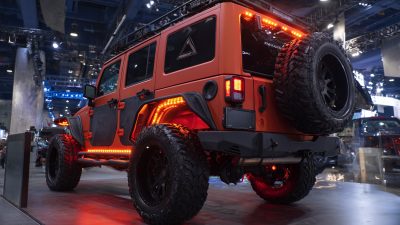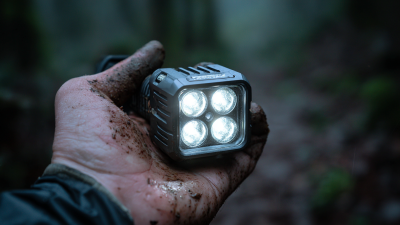Leave Your Message
As off-road adventures continue to gain popularity, ensuring rider safety during night excursions has become a pressing concern. According to the Consumer Product Safety Commission, over 15,000 ATV-related injuries occur annually in the United States, with many accidents happening in low-visibility conditions. This highlights the critical importance of effective safety measures, particularly when it comes to nighttime riding.

ATV whip lights have emerged as an essential accessory for enhancing visibility and communication among off-road enthusiasts. These lights not only improve the rider's visibility to others but also help in marking the trail and navigating safely through rugged terrains.
In this comprehensive guide, we will explore the best practices and top-rated ATV whip lights that can significantly boost night riding safety, helping riders to enjoy their adventures while minimizing risks.
When it comes to off-road adventures, choosing the right ATV whip lights is crucial for ensuring both visibility and safety during night rides. A study from the Outdoor Industry Association indicates that more than 30% of off-road incidents occur during low-light conditions, making adequate lighting essential. Whip lights significantly enhance visibility, allowing riders to be seen from a distance, which can prevent accidents among fellow riders and wildlife alike.
When selecting whip lights, consider factors such as brightness, height, and durability. LED options typically provide the best illumination and energy efficiency, which is crucial for extended riding sessions. According to recent industry reports, the optimal height for whip lights is between 6 to 8 feet, as this range allows for maximum visibility without obstructing the rider’s line of sight. Additionally, look for features like weatherproofing and easy installation, which can improve functionality in challenging outdoor conditions. With the right whip lights, the thrill of night riding can be enjoyed safely and confidently.
| Feature | Description | Benefits | Recommendation |
|---|---|---|---|
| Height | Standard heights range from 4 to 6 feet | Increases visibility from a distance | 6 feet for maximum visibility |
| Color Options | Available in various colors like red, blue, and green | Different colors can signify different events or hazards | Choose based on visibility needs or personal preference |
| Material | Common materials include flexible PVC or LED tubes | Durability and resistance to elements | Opt for high-quality materials for longevity |
| Power Source | Battery-operated or wired options | Flexibility in installation and use | Choose based on your riding preferences |
| Installation | Easy installation with minimal tools required | Quick setup allows for more ride time | Look for plug-and-play options |
Night riding presents unique challenges, particularly for off-road enthusiasts. Statistics reveal that riders, such as those on ATVs, are not afforded the same safety protections as those in passenger vehicles; they experience significantly higher exposure to accidents under low-visibility conditions. The National Highway Traffic Safety Administration (NHTSA) highlights that motorcyclists are 29 times more likely to be involved in fatal crashes than occupants of passenger vehicles. This alarming figure underscores the critical need for enhanced visibility during nighttime adventures.
To improve safety, it’s essential to make sure that you are seen by others on the road. Utilizing ATV whip lights can be an effective solution. These lights not only increase your visibility but also allow you to judge your distance from surrounding obstacles. Here are some tips:
- **Invest in Quality Lighting**: Ensure your whip lights are bright and energy-efficient, offering visibility from a distance.
- **Positioning Matters**: Mount your lights at a height and angle that maximizes visibility, ideally above the vehicle's standard line of sight.
- **Stay Aware of Surroundings**: On dark trails, always remain vigilant and be prepared to react promptly to potential hazards, as visibility can change rapidly.
By implementing these strategies, ATV riders can significantly reduce their risk of accidents and enjoy safer off-road adventures.

When it comes to enhancing night riding safety, ATV whip lights are an essential addition for off-road enthusiasts. These accessories come in various types, including LED lights, reflective whip lights, and flexible whip lights. LED whip lights are popular due to their brightness and energy efficiency, providing excellent visibility in dark environments. Reflective whip lights, on the other hand, offer a cost-effective solution for those who want to enhance their presence without the need for electricity. Lastly, flexible whip lights can adapt to rough terrains, ensuring durability while maintaining visibility during adventurous rides.
Each of these whip light types has unique features and benefits tailored for off-road enthusiasts. For instance, many LED versions offer multi-color options, allowing riders to customize their vehicles and increase safety through color-coded visibility. Reflective whip lights serve as passive safety devices, reflecting light from other vehicles, improving awareness in dimly lit areas. Flexible whip lights cater to those who often navigate uneven surfaces, made from sturdy materials that withstand harsh conditions, ensuring they do not break easily while riding. Choosing the right type of ATV whip lights can significantly elevate both safety and enjoyment during night rides.
Proper installation of ATV whip lights is crucial for enhancing safety during night riding adventures. First, ensure that you select the right type of whip lights suited for your specific ATV model and the terrain you'll be riding on. The installation process usually involves mounting the lights securely to the back of the ATV, ensuring they are visible from a distance. It’s essential to use durable mounting hardware that can withstand the rigors of off-road environments. Before securing the lights, position them in a way that won’t obstruct your view or get entangled in branches and foliage.
Once installed, regular maintenance is key to keeping your whip lights functional. Periodically check the wiring for any signs of wear or damage, and ensure that the lights are securely fastened to avoid any accidents during your ride. Cleaning the lights regularly will also help maintain visibility and effectiveness. Consider using water-resistant covers to protect against mud and dirt, which can dim their brightness. By following these installation and maintenance tips, you can significantly improve your visibility and safety while enjoying nighttime off-road adventures.
When embarking on off-road adventures, understanding the legal regulations surrounding off-road lighting is essential for every rider. These regulations can vary significantly by location, affecting where and how riders can use their vehicles. In many regions, including places like Utah, regulations ensure that riders are equipped with appropriate safety gear, such as ATV whip lights, particularly during night rides. These lights not only enhance visibility but also help in complying with local laws designed to ensure the safety of all trail users.

Riders must be aware of specific laws, such as restrictions on operating off-road vehicles on public roads or using prohibited lighting. Recent guidance emphasizes the importance of riding in designated areas and adhering to seasonal closures, especially in regions with diverse landscapes like the Eldorado National Forest. Additionally, as the popularity of electric bikes rises, riders face scrutiny regarding their legal status and required safety measures.
Being informed about these regulations can significantly enhance safety and enjoyment while exploring off-road trails, allowing riders to navigate the complexities of their local laws confidently.






